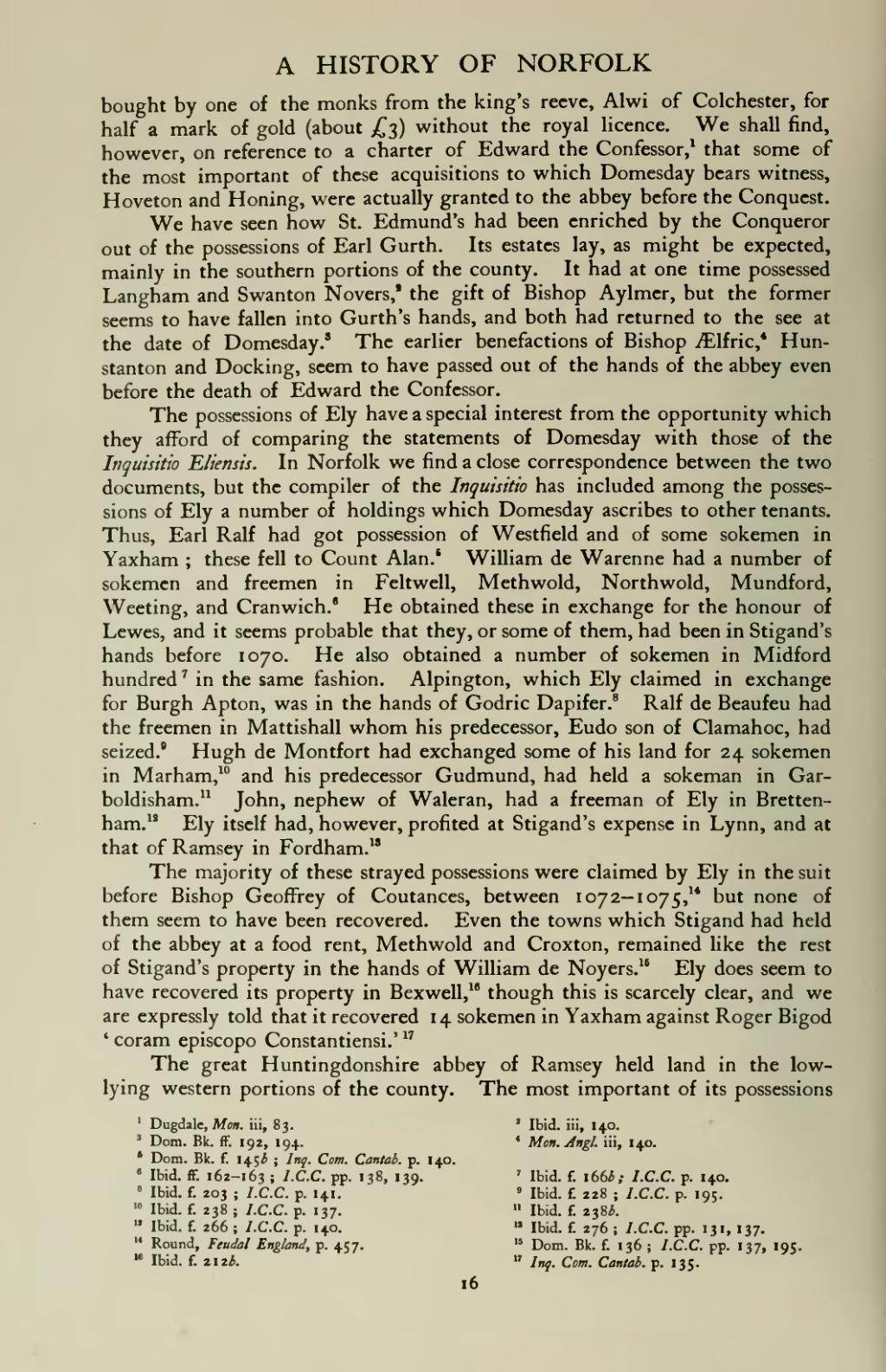A HISTORY OF NORFOLK bought by one of the monks from the king's reeve, Alwi of Colchester, for half a mark of gold (about ;C3) without the royal licence. We shall find, however, on reference to a charter of Edward the Confessor,^ that some of the most important of these acquisitions to which Domesday bears witness, Hoveton and Honing, were actually granted to the abbey before the Conquest. We have seen how St. Edmund's had been enriched by the Conqueror out of the possessions of Earl Gurth. Its estates lay, as might be expected, mainly in the southern portions of the county. It had at one time possessed Langham and Swanton Novers,* the gift of Bishop Aylmer, but the former seems to have fallen into Gurth's hands, and both had returned to the see at the date of Domesday.* The earlier benefactions of Bishop iElfric,* Hun- stanton and Docking, seem to have passed out of the hands of the abbey even before the death of Edward the Confessor. The possessions of Ely have a special interest from the opportunity which they afford of comparing the statements of Domesday with those of the Inquisitio Eliensis. In Norfolk we find a close correspondence between the two documents, but the compiler of the Inquisitio has included among the posses- sions of Ely a number of holdings which Domesday ascribes to other tenants. Thus, Earl Ralf had got possession of Westfield and of some sokemen in Yaxham ; these fell to Count Alan.' William de Warenne had a number of sokemen and freemen in Feltwell, Methwold, Northwold, Mundford, Weeting, and Cranwich.* He obtained these in exchange for the honour of Lewes, and it seems probable that they, or some of them, had been in Stigand's hands before 1070. He also obtained a number of sokemen in Midford hundred ^ in the same fashion. Alpington, which Ely claimed in exchange for Burgh Apton, was in the hands of Godric Dapifer.® Ralf de Beaufeu had the freemen in Mattishall whom his predecessor, Eudo son of Clamahoc, had seized.' Hugh de Montfort had exchanged some of his land for 24 sokemen in Marham,^" and his predecessor Gudmund, had held a sokeman in Gar- boldisham.^^ John, nephew of Waleran, had a freeman of Ely in Bretten- ham." Ely itself had, however, profited at Stigand's expense in Lynn, and at that of Ramsey in Fordham." The majority of these strayed possessions were claimed by Ely in the suit before Bishop Geoffrey of Coutances, between 1072—1075,^* but none of them seem to have been recovered. Even the towns which Stigand had held of the abbey at a food rent, Methwold and Croxton, remained like the rest of Stigand's property in the hands of William de Noyers." Ely does seem to have recovered its property in Bexwell," though this is scarcely clear, and we are expressly told that it recovered 14 sokemen in Yaxham against Roger Bigod ' coram episcopo Constantiensi.' " The great Huntingdonshire abbey of Ramsey held land in the low- lying western portions of the county. The most important of its possessions ' Dugdale, Afos. iii, 83. ' Ibid, iii, 140. ' Dom. Bk. fF. 192, 194. * Mon. Angl. iii, 140. ' Dom. Bk. f. 1453 ; Inq. Com. Cantab, p. 140. « Ibid. fF. 162-163 ; I.C.C. pp. 138, 139. ' Ibid. f. i663,- I.C.C. p. 140. ' Ibid. f. 203 ; I.C.C. p. 141. ' Ibid. f. 228 ; I.C.C. p. 195. '" Ibid. f. 238 ; I.C.C. p. 137. " Ibid. f. 2383. " Ibid. f. 266 ; I.C.C. p. 140. " Ibid. f. 276 ; I.C.C. pp. 131, 137. " Round, Feudal England, p. 457. " Dom. Bk. f. 136 ; I.C.C. pp. 137, 195. '^ Ibid. f. 212*. " Inq. Com. Cantab, p. 135. 16
